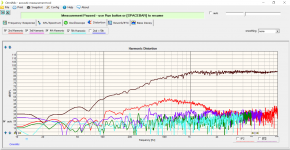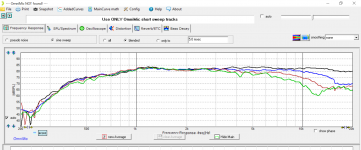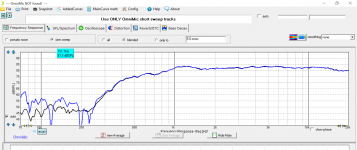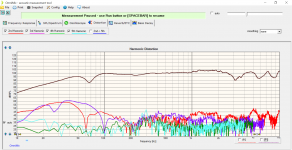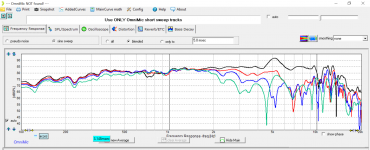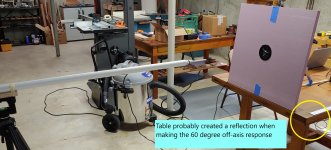My new drivers arrived today. A pair of TW29TXN-B and a pair of MW16TX-4.
I am fabricating a baffle to do some measurements. I am using a 24"x24" sheet of XPS foam board (thanks to XRK971 for recommending this). I hope to have some results in a couple of days... Frequency response on and off axis, harmonic distortion, etc..
When using the XPS for the woofer, be careful to use some sort of bracing, CLD, or mass damped butyl sheets to dampen the panels. They make excellent DML (distributed mode loudspeaker) panels, and I have used them as such when unbraced. The can resonate and re-radiate sound if the vibrations are allowed to propagate freely.
A Study of DML's as a Full Range Speaker
Impedance for TW29TXN-B tweeters
The two tweeters TW29TXN-B have serial numbers xyz760 and xyz764.
Here are the impedance data for the two tweeters. The zip file contains the zma files.
The two tweeters TW29TXN-B have serial numbers xyz760 and xyz764.
Here are the impedance data for the two tweeters. The zip file contains the zma files.
Attachments
Impedance for MW16TX-4 MidWoofers
The two woofers MW16TX-4 have serial numbers xyz093 and xyz126.
Here are the impedance data for the two drivers. The zip file contains the zma files.
The woofers have had no break-in. Since I plan to use these as midrange drivers, the exact T/S parameters are not important to me so I do not plan any break-in loading.
The two woofers MW16TX-4 have serial numbers xyz093 and xyz126.
Here are the impedance data for the two drivers. The zip file contains the zma files.
The woofers have had no break-in. Since I plan to use these as midrange drivers, the exact T/S parameters are not important to me so I do not plan any break-in loading.
Attachments
Frequency response for TW29TXN-B tweeters
I know everyone is waiting for the MW16TX measurements, but I wanted to make sure my measurement technique is competent. So I did the tweeters first so I could compare with HiFi Compass to see if I could duplicate his excellent work.
Satori TW29TXN-4 | HiFiCompass
Frequency response for TW29TXN-B tweeters were made at a distance of 50 cm (19.5 inches). Harmonic distortion measurements were made at a distance of 32 cm to be consistent with HiFi Compass.
The first plot shows the on-axis frequency response of the two tweeters. They are almost exactly the same. This confused me at first and I thought I accidently took two measurements of the same driver, so I repeated it... the two tweeters really do match each other that well...
The second plot shows the off-axis response of one of the drivers (S/N xyz764).
I plotted 0, 30, 45, 60 degrees. These results very closely match HiFi Compass.
The final plot is the harmonic distortion. This plot differs from HiFi compass, probably due to the noise floor in my environment, which is about 30 dB (or about 55 dB below the test signal). This means I can't measure distortion below that threshold. HiFi Compass measured 3rd HD at about -70 dB, and I just can not get that low with my test setup... Regardless, my measurements show that this tweeter has distortion levels of at least -55 dB from 2kHz up. So I am consistent with HiFi Compass to the limits of my test environment.
HiFi Compass used a high pass filter when measuring HD on this driver... I do not have one convenient, so I was hesitant to go above 85 dB SPL with a full sine sweep... especially with a $235 driver...
I am attaching the FRD files. Please be aware the phase in these files is "as measured", and the low frequency garbage has not been trimmed out. I would consider anything below 250 Hz as garbage.
I know everyone is waiting for the MW16TX measurements, but I wanted to make sure my measurement technique is competent. So I did the tweeters first so I could compare with HiFi Compass to see if I could duplicate his excellent work.
Satori TW29TXN-4 | HiFiCompass
Frequency response for TW29TXN-B tweeters were made at a distance of 50 cm (19.5 inches). Harmonic distortion measurements were made at a distance of 32 cm to be consistent with HiFi Compass.
The first plot shows the on-axis frequency response of the two tweeters. They are almost exactly the same. This confused me at first and I thought I accidently took two measurements of the same driver, so I repeated it... the two tweeters really do match each other that well...
The second plot shows the off-axis response of one of the drivers (S/N xyz764).
I plotted 0, 30, 45, 60 degrees. These results very closely match HiFi Compass.
The final plot is the harmonic distortion. This plot differs from HiFi compass, probably due to the noise floor in my environment, which is about 30 dB (or about 55 dB below the test signal). This means I can't measure distortion below that threshold. HiFi Compass measured 3rd HD at about -70 dB, and I just can not get that low with my test setup... Regardless, my measurements show that this tweeter has distortion levels of at least -55 dB from 2kHz up. So I am consistent with HiFi Compass to the limits of my test environment.
HiFi Compass used a high pass filter when measuring HD on this driver... I do not have one convenient, so I was hesitant to go above 85 dB SPL with a full sine sweep... especially with a $235 driver...
I am attaching the FRD files. Please be aware the phase in these files is "as measured", and the low frequency garbage has not been trimmed out. I would consider anything below 250 Hz as garbage.
Attachments
Last edited:
Here are the measurements for the MW16TX-4 midwoofer. I measured just one of them (S/N xyz093) because my foam board baffle was slightly damaged when I removed the driver at the end of testing. Plus I am lazy.
As before, the FR data was taken at 50 cm. To be consistent with HiFi Compass, the harmonic distortion data was taken at 25mm (1 inch).
The first curve is the FR response at 0, 30, 45, 60 degrees. The next is the same data normalized to the 0 degree axis.
The next curve is the near field response, and then the near field response over-layed with the 0 degree axis gated response.
The harmonic distortion data was taken nearfield at about 25 mm. HiFi Compass recommends the near field HD data for woofers, and the 300 mm data for tweeters. I got my noise floor down a little, so I think these measurements are good down to -70 dB.
I have not studied the data yet, but so far it seems these drivers are quite nice.
As before, the FR data was taken at 50 cm. To be consistent with HiFi Compass, the harmonic distortion data was taken at 25mm (1 inch).
The first curve is the FR response at 0, 30, 45, 60 degrees. The next is the same data normalized to the 0 degree axis.
The next curve is the near field response, and then the near field response over-layed with the 0 degree axis gated response.
The harmonic distortion data was taken nearfield at about 25 mm. HiFi Compass recommends the near field HD data for woofers, and the 300 mm data for tweeters. I got my noise floor down a little, so I think these measurements are good down to -70 dB.
I have not studied the data yet, but so far it seems these drivers are quite nice.
Attachments
With Steps (Arta) you can set the frequency range you want to measure, so if you set that to 1000 - 20000hz, you can use a much higher signal, without damage.
Oh yes, Arta is very powerful. Thanks for the tip...
Thoughts on tweeter measurements:
My off-axis response shows some wiggles in the 60 degree horizontal curve, and HiFi Compass does not show a similar wiggle. I think this is a test setup deficiency on my part. I think I was getting a reflection from the table.
When making the on-axis measurements, I made sure the concrete floor was the nearest reflection. It showed up well in the impulse response, and I was able to set my gating at about 4.7 ms. But as I moved off axis, the impulse response was increasingly muddy and I had to shrink the gating window. At 60 degrees, I was not really able to determine a clean gating window.
My off-axis response shows some wiggles in the 60 degree horizontal curve, and HiFi Compass does not show a similar wiggle. I think this is a test setup deficiency on my part. I think I was getting a reflection from the table.
When making the on-axis measurements, I made sure the concrete floor was the nearest reflection. It showed up well in the impulse response, and I was able to set my gating at about 4.7 ms. But as I moved off axis, the impulse response was increasingly muddy and I had to shrink the gating window. At 60 degrees, I was not really able to determine a clean gating window.
Attachments
Last edited:
Hey HifiJim : wonderful workshop you have... cool, all one needs to saw wood for speakers 
Maybe try with a longer rod for the mic maybe ?
Ho would you comment the 16TX unit please ? I have pain to have a definitive statment ! Surely the little hle between 700 and 800 hz is due to the bafle but if a bafle step effect the +5 db between 800 hz and 2 k hz makes it less flat than a Satori for instance ???
Thank you again for all the work...
Maybe try with a longer rod for the mic maybe ?
Ho would you comment the 16TX unit please ? I have pain to have a definitive statment ! Surely the little hle between 700 and 800 hz is due to the bafle but if a bafle step effect the +5 db between 800 hz and 2 k hz makes it less flat than a Satori for instance ???
Thank you again for all the work...
Thoughts on MW16TX
One of the things I failed to do when measuring this driver was to find the cone breakup. I tried looking at energy storage plots and CSD plots, but I did not really see a pronounced cone resonance. In truth I have never been quite happy with my mic/boom/software ability to make a good CSD plot. I always get some low level hash at around -20 dB.
I can usually pick out cone breakup by looking at the on-axis and off-axis response. With a metal cone it is usually quite obvious. With this driver it is harder to find. The ideal rigid cone will have off axis cancellations showing up first at 60 degrees, then 45, then 30. At the same time, the on axis response will be peaking due to beaming. I see this in the MW16TX response. Somewhere above 9 kHz there is probably some kind of cone breakup, but it is not a sharp high-Q ringing like a metal cone. It seems more like a soft breakup similar to a good poly cone, or a doped paper cone.
It is possible there is some kind of cone breakup happening at 5-6 kHz. I saw a "blip" in the CSD plots at 5 k, but it was so close to the limit of my measurement capability I am not sure I believe it. There is also a very very slight wrinkle in the impedance curve at about 5k. The 2nd harmonic distortion also rises up a bit from 5k to 6k... from -60 to -50 dB (inaudible). If there is something going on at 5k, it is so well controlled as to be insignificant.
So I would say this driver is similar to a good polycone or paper cone, except that instead of being pistonic to 800 hz with well controlled breakup above, it is pistonic to 10 k... pretty impressive.
One of the things I failed to do when measuring this driver was to find the cone breakup. I tried looking at energy storage plots and CSD plots, but I did not really see a pronounced cone resonance. In truth I have never been quite happy with my mic/boom/software ability to make a good CSD plot. I always get some low level hash at around -20 dB.
I can usually pick out cone breakup by looking at the on-axis and off-axis response. With a metal cone it is usually quite obvious. With this driver it is harder to find. The ideal rigid cone will have off axis cancellations showing up first at 60 degrees, then 45, then 30. At the same time, the on axis response will be peaking due to beaming. I see this in the MW16TX response. Somewhere above 9 kHz there is probably some kind of cone breakup, but it is not a sharp high-Q ringing like a metal cone. It seems more like a soft breakup similar to a good poly cone, or a doped paper cone.
It is possible there is some kind of cone breakup happening at 5-6 kHz. I saw a "blip" in the CSD plots at 5 k, but it was so close to the limit of my measurement capability I am not sure I believe it. There is also a very very slight wrinkle in the impedance curve at about 5k. The 2nd harmonic distortion also rises up a bit from 5k to 6k... from -60 to -50 dB (inaudible). If there is something going on at 5k, it is so well controlled as to be insignificant.
So I would say this driver is similar to a good polycone or paper cone, except that instead of being pistonic to 800 hz with well controlled breakup above, it is pistonic to 10 k... pretty impressive.
Attachments
Surely the little hle between 700 and 800 hz is due to the bafle but if a bafle step effect the +5 db between 800 hz and 2 k hz makes it less flat than a Satori for instance ???
If you look back at post #549 you can see the near field response. I believe this is accurate up to 1000 Hz. It is the total acoustical power output of the driver. It is very flat between 300 and 1000.
There is some baffle effect going on. I did not make an infinite baffle measurement, it is a 24" x 24" baffle, which is not quite the same as an IEC baffle. Whoever uses the FRD files needs to keep in mind the difference between this test baffle and their baffle.
If you want to be sure, you might find some additional insight in the HD spectrum. H2 or H3 can sometimes spike at 1x breakup frequency.
Between 2k and 4k the H2 hovers around -60 dB to -65 dB. Between 4k and 5k it rises up to -50 dB, then at 6k it settles back down. So we do see a "spike" in H2, from 0.1% to 0.3%. So yes it could be cone breakup or some other resonance in the voice coil / spider / surround... if so, it is the most mild, well behaved cone breakup ever... Like a really good silk dome tweeter which operates in breakup over its whole pass band, but yet has no measurable resonance...
Yes I noticed a small wrinkle in the impedance curve at about 5k. Your measurement has a little bigger 5k bump than mine, but the wrinkle is present in both yours and mine.
think you have DATS V2 version and I have DATS V3 version. DATS V3 is more accurate and more powerfull - resonance impedance graph is steeper, peak higher. Therefore, in my opinion, the subtle differences
And I agree it´s very good speaker I prepare make two way and three way speaker with Bliesma´s tweeters B26
I noticed that you like textreme Satori tweeter more than beryllium Satori? Or it was the guy from the Kaiser company? I made some three way´s speaker with beryllium Satori - not bad, maybe very good, but slightly overrated. I'm a little curious about textreme tweeter...
- Home
- Loudspeakers
- Multi-Way
- SB Acoustics Textreme
